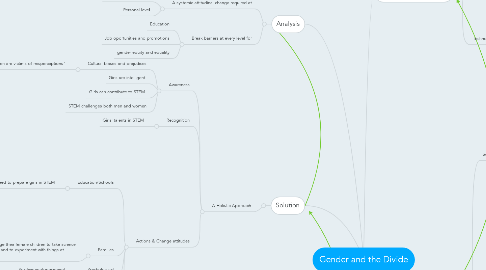
1. Analysis
1.1. A systemic attitudinal change required at
1.1.1. Socio-institutional level
1.1.2. Personal level
1.2. Break barriers at every level for
1.2.1. Education
1.2.2. Job oportunities and promotions
1.2.3. gender equity and equality
2. Solution
2.1. A Holistic Approach
2.1.1. Awareness
2.1.1.1. Cultural biases and prejudices
2.1.1.1.1. "Women are victims of misperceptions"
2.1.1.2. Girls are intelligent.
2.1.1.3. Girls can contribute to STEM.
2.1.1.4. STEM challenges both men and women
2.1.2. Recognition
2.1.2.1. Girls' talents in STEM
2.1.3. Actions & Change attitudes
2.1.3.1. Education/Schools
2.1.3.1.1. Need to prepare girls in STEM
2.1.3.2. Families
2.1.3.2.1. Encourage their female children to take science subjects and to experiment with things at home
2.1.3.3. Psychological
2.1.3.3.1. Positive reinformcement
2.1.3.4. Work Environment
2.1.3.4.1. Provide conducive safe work environment
2.1.3.4.2. Provide flex-time and telecommuniting
2.1.3.4.3. Provide transparent promotion procedures and performance evaluation
2.1.3.4.4. Provide equal salaries, opportunities, resources and mentors
3. Effects
3.1. Social/Institutional level
3.1.1. Losing talented potential female scientists, mathematicians, Engineers, technical experts
3.2. Personal level
3.2.1. Less motivation
3.2.2. Less committment
3.2.3. Less achievement
3.2.4. Less satisfisfaction
4. Current Scenario: STEM
4.1. Science, Math & Engineering
4.1.1. Physics Professors
4.1.1.1. 14% women
4.1.2. PhD in Physics /year
4.1.2.1. 20% women
4.1.2.2. 13 African Americans/year
4.1.2.3. 20 Latinos /year
4.1.3. Undergraduates majoring in Physics
4.1.3.1. 30 % to 40% women
4.1.4. Preparing to take Physics in High schools
4.1.4.1. From 1987 to 2013: from 39% to 47% increase
4.2. Technology: Computer Science
4.2.1. Women in computer related jobs
4.2.1.1. Decline from 36% in 1991 to 25% in 2008
4.2.1.2. Leaving IT jobs
4.2.1.2.1. 41% after 10 years of experience
4.2.1.2.2. 56% after 10 to 20 years of experience
5. Factors
5.1. Socio-cultural
5.1.1. Institutional
5.1.1.1. Masculine culture
5.1.1.1.1. Viewing male scientists favorably
5.1.1.1.2. Portraits of geeky male scientists only having talents
5.1.1.1.3. Disparity between men and women in salary, space, awards and resources
5.1.1.1.4. less opportunities for women's career advancement
5.1.1.2. gender bias/prejudices
5.1.1.2.1. "biological inequalities in sexes"
5.1.1.3. Male dominance in science
5.1.2. Individual
5.1.2.1. Male
5.1.2.1.1. Feeling superiority over over women
5.1.2.2. Female
5.1.2.2.1. Internal voices
5.1.2.2.2. "tend to camouflage their mathematical talents to fit in well with their peers"
5.2. Psychological
5.2.1. Fear of failure
5.2.2. Feeling of "I'm not good"
5.2.3. Feeling lonely due to long duration of studies
5.2.4. Feeling under-appreciated & not encouraged
5.3. Schools, Families, & Communities
5.3.1. Schools
5.3.1.1. Less equipped to train girls in spatial skills & Llabs
5.3.1.2. Misperception of girls' talents
5.3.1.3. No encouragement from teachers/professors
5.3.2. Families
5.3.2.1. Not encourging girls to take STEM
5.3.2.2. Viewing girls studying science subjects will not earn much.
5.3.2.3. Fewer arguments when girls drop science subjects
5.3.3. Communities
5.3.3.1. Lack of female role models
5.4. Work Environment
5.4.1. Disparity in Salary, space, awards and resources disparity between men and women
5.4.2. Rigid work time
5.4.3. Inhospitable work environment
5.4.4. Less transparent performance evaluation and promotion
5.4.5. Less opportunities for career advancement
5.4.6. Less encouragement for tele-commuting
5.4.7. Lack of mentors and sponsors
5.5. Work/life Balance
5.5.1. Obliged to take care of children and families
5.5.2. Difficult to balance work and life commitments
